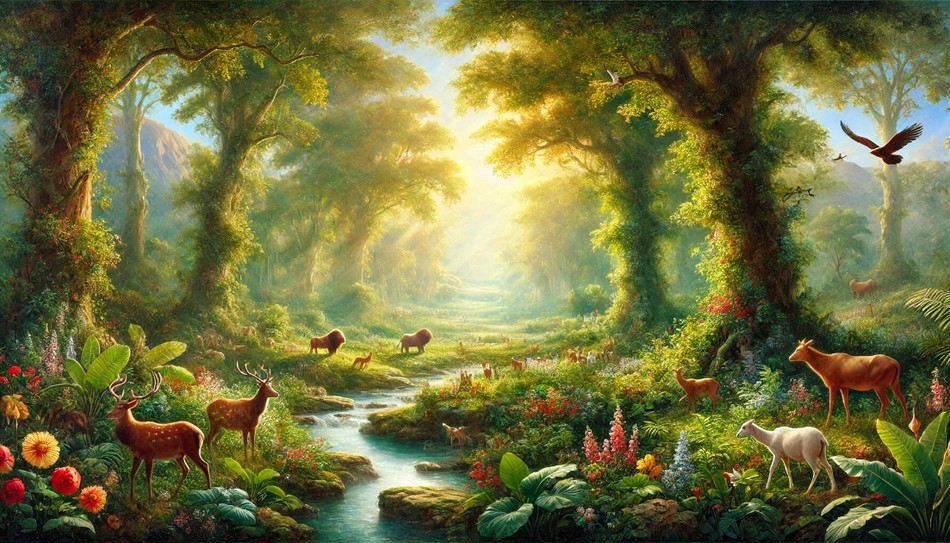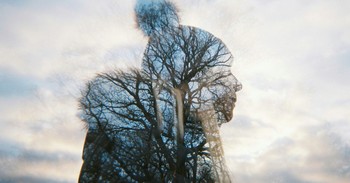It matters how things begin.
Each superhero has an origin story. While each character might have been conceived as the hero, comics early on realized the need to explain how and why a person became a “superhero.” Whether being bitten by a radioactive bug or a massive tragedy in their past, the comics and movies give us the character and purpose of our heroes. And villains.
We live in the world as it is, and yet we have questions. Corruption and brokenness surround us, and it feels wrong. Like it wasn’t meant to be this way. Our instinct proves true: it wasn’t.
Therefore, the Bible tells us how it all began, what God intended with creation and our lives, including a perfect world we all long for. The Garden of Eden stands as a paradise, an ideal we’re constantly reaching for or trying to manufacture and failing miserably. Eden becomes a paradise lost. But is it lost forever?
Looking at what Scripture tells us about the Garden of Eden teaches us about God, his plan, and what redemption looks like.
What Was God’s Original Design and Purpose for the Garden of Eden?
God designed the Garden of Eden as an outpost of heaven on earth.
When God created the earth, he left the earth unfilled. Unformed and empty. He created animals and fish and plants, organized the environment. And yet his real work began with fashioning the Garden of Eden and humanity.
The Lord designed Eden as more than a paradise for humans to enjoy. It was a place where heaven and earth met. The Garden revealed God’s creative order, filled with beauty, abundance, and life. God placed the man and woman made in his image within it. The outpost of heaven on earth required someone made in God’s image to tend it. But even further, God gave humanity a mission: through making more people in God’s image (a family and descendants), they were to rule and extend heaven on earth to the whole world.
Eden also functioned as a temple-like space where God met with humanity in intimate fellowship. At the center of perfect human life stood the worshipful relationship with God. As God commanded the plants and animals to be fruitful, he did the same with Adam and Eve, to “be fruitful and multiply, fill the earth and subdue it” (Genesis 1:28). Eden, then, was only the beginning. God designed humanity to expand the boundaries of paradise through loving family, filling the “empty” earth as one outpost of heaven.
The Garden had every kind of tree, with the Tree of Life at the center, a type of Christ as the source and central to a life of paradise. Next to it stood the Tree of the Knowledge of Good and Evil, which humanity was to reject, their only limitation. God alone could be their guide and goodness. From this place and mindset, humanity acted like the creator, working to bring creative order to the world.
And yet this mission was interrupted by sin. Eve and Adam fell to temptation and disobeyed. Through eating of the Tree of the Knowledge of Good and Evil, they took the moral responsibility on themselves and away from God. Taking the fruit of that tree rejected the Tree of Life, which led to death.
But the story doesn’t end there.
Where Was the Garden of Eden?
The Bible gives a specific and real location for Eden, although a few thousand years later, the exact boundaries are uncertain. Genesis 2:10-14 describes a river flowing from Eden and splitting into four—Pishon, Gihon, Tigris, and Euphrates. The Tigris and Euphrates flow through modern-day Iraq, so scholars think Eden would be in Mesopotamia, maybe ancient Sumer or southern Turkey. Theories exist about the other two rivers but nothing concrete.
Eden probably existed in or near what we call the Fertile Crescent, named such because of its amazingly fertile land, perfect for starting and sustaining agriculture, central to starting any growing civilization. This large region stretched from the Persian Gulf through what is now Iraq, Syria, Israel, and Egypt.
Interestingly, the Promised Land of Israel, where God led his people from Egyptian slavery, exists in the same general area where Eden likely existed. Further, God describes Canaan with language like “a land flowing with milk and honey” (Exodus 3:8), pointing back to an Edenesque area teeming with life. Here, in this abundant and fertile land, the Lord intended to dwell with his people. In this Promised Land, his blessings would flow as they lived in obedience and spread his name to the surrounding nations.
Just as Eden was to be cultivated by Adam and Eve, God gave Israel a Law to maintain and manage a new type of holy paradise, ruled with justice, worshipping the only real God. While Eden and Canaan aren’t exactly the same, both represent God’s desire for a people to live a type of heaven on earth, a family living under his guidance and spreading his glory to the world.
How Did the Tabernacle and Temple Connect with the Garden of Eden?
Just as the Tree of Life stood at the center of Eden, the core of Israel was the worship of the true God at the Tabernacle and then Solomon’s Temple. Even these structures contained the imagery and purpose of Eden, a sacred place of heaven on earth where God’s presence met with his people.
Like the Garden of Eden, the Tabernacle and Temple were both entered from the east. Cherubim, the angels who kept people from getting back into Eden after the Fall (Genesis 3:24), sit on the Ark of the Covenant in the Holy of Holies, hidden behind a thick curtain embroidered with the same angels. These images taught that while humanity lost access to God through sin, he could now be approached again through this structure.
Solomon placed images of palm trees, flowers, and pomegranates throughout the Jerusalem Temple, Edenic pictures of fruitfulness. Gold covered the holiest places and objects, referring back to the riches described within Eden (Genesis 2:11-12). While not said outright, the Temple clearly became a new Eden, God’s dwelling place on earth, where humans could meet with him and be blessed.
God’s glory hovered over the Tabernacle in the wilderness as a cloud or fire, and the same glory descended on Solomon’s Temple as a cloud. The Lord’s presence rested on the mercy seat. Priests functioned like Adam and Eve to “work and keep” the Garden. Numbers 3:7-8 even uses the same Hebrew words as tending the Garden when referring to priestly duties in the Tabernacle.
Through the Promised Land, the Tabernacle, and the Temple, God began to restore what was lost. And yet it didn’t fulfill the real redemption, only in part. That would have to come in Jesus later.
How Did Jerusalem Become a Type of Garden of Eden?
The Tabernacle never rested in Jerusalem. And yet with the building of Solomon’s Temple, the whole city became a spiritual symbol for God’s presence or heaven on earth, a theme which progressed through Old Testament prophets.
David gave Jerusalem his name when he captured it and established it as the new capital of a unified kingdom of Israel. It claimed deeper importance when he brought the Ark of the Covenant to the city and put it under an open tent, seen by everyone. The Bible calls this the Tabernacle of David. David made plans for a Temple on Mount Moriah (the same mountain where Abraham went to sacrifice Isaac), but God wouldn’t let him due to his violent past. Instead, Solomon built a glorious Temple. With God’s glory there, Jerusalem became the fixed spiritual center of Israel, where heaven and earth met. Pilgrims from all over came to Jerusalem for festivals, sacrifices, and worship.
The prophets saw continued and growing revelation about Jerusalem’s purpose and future. Even when the Jews sinned in idolatry and corruption, the prophets declared the future restoration. Isaiah 60:14 calls Jerusalem the “city of the Lord, the Zion of the Holy One of Israel.” All nations would one day travel to Jerusalem to seek God’s teaching. Micah prophesied how the Lord’s house (Temple, Jerusalem, the people) would be lifted high again, more than ever, and the nations would say, “Let us go up to the mountain of the Lord.” (Micah 4:1-2) The very real place of Jerusalem became a symbol of redemption, justice, and godly abundance.
Yet Jerusalem was built by men with corruptible materials. The sins of Judah led to the destruction of the Temple and Jerusalem. Even so, prophets like Ezekiel and Zechariah looked forward to a new Jerusalem, an eternal one filled with peace and glory. Ezekiel saw a vision of a new temple where life-giving waters would flow. God’s people, now from every nation, would live there in healing and safety. This Edenic language points to a time when God himself will bring his people back to an outpost of heaven on earth.
But this couldn’t be made with human hands. God himself had to do it for it to last forever.
How Will the New Jerusalem Restore the Garden of Eden?
As we’ve seen, God doesn’t give up on his perfect ideas. His word doesn’t return void, and he will do and have what he wills. We will be brought back to Eden, in a sense, but a more glorious one.
To begin with, the church now becomes the temple of God through the indwelling Holy Spirit. We are his dwelling place on earth. Jesus sent this Spirit after his resurrection and ascension, to live with us so we could be his witnesses on earth (Acts 2). No longer in an easily destroyed building, God now inhabits a reborn, eternal people, the “temple of the Holy Spirit” (1 Corinthians 3:16, Ephesians 2:19-20). Just as God’s presence filled the Tabernacle and Temple, his Spirit fills the church.
We multiply reborn people not by physical means, as they did in Israel, but through making disciples, preaching the Gospel of the Kingdom and King Jesus to the world. The Spirit through us brings loving dominion through the earth. The reborn people function as a kingdom of priests; we offer spiritual sacrifices and declare the Good News of Christ to the nations.
As we’re being built into an eternal Temple (or house, 1 Peter 2:5), Revelation shows us how this will be fulfilled in the end. In Revelation 21-22, the New Jerusalem descends from heaven to a new, redeemed earth. The New Jerusalem has no temple, “for the Lord God Almighty and the Lamb are its temple.” God’s presence fills the whole city, making it a holy dwelling for his people.
Edenic imagery returns. The river of life flows from God’s throne, like the river in Genesis 2. The Tree of Life comes back, too, bearing fruit for healing and life (Revelation 22:1-2). There is no curse, death, or separation. God walks again with his people in the ultimate restoration of heaven on earth. In a greater way, God brings us back to the Garden of Eden at the end of the story.
Peace.
Image created using DALL.E 2024 AI technology and subsequently edited and reviewed by our editorial team.





